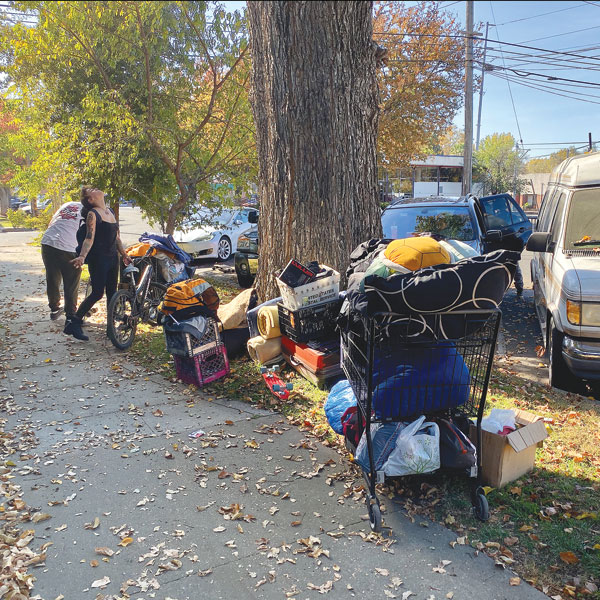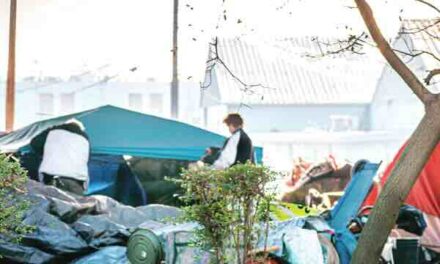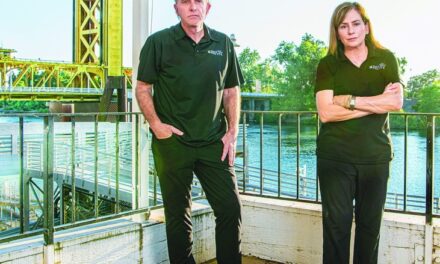While flipping through cable news shows a couple months ago, I came across an interview with a Sacramento resident named Elizabeth Novak. She made national news by posting a desperate—but heartfelt—video message to Gov. Gavin Newsom on social media.
Novak, who owned and operated a hair salon on Broadway in Land Park, posted a video on Twitter describing how difficult it was to run her business during the homeless crisis. She asked how the governor was going to help. I was intrigued because I’ve had small-business owners reach out to me with similar problems.

“When I get to work each day I have to clean up human waste off of my doorstep. I have to clean up the syringes. I have to politely ask the people who I care about—and I do care for the people that are homeless—to move their tents out of the way of the door to my business,” Novak said. She described fighting off drug-addicted people who pushed their way into her shop because the police aren’t able arrest them for drug offenses. She apologized to clients daily for the mess and filth.
“You want to make a sanctuary state, you want to make it comfortable for everybody except for the people that work hard and try their hardest to get along in life. But … your liberal ideology is not working. And I don’t understand who you’re trying to please. You … don’t have to look at what we have to look at,” she said in her plea to Newsom. “What are you going to do for us?”
Sadly, Novak is one of thousands of small-business owners in West Coast cities who deal with this problem. I am convinced our political leaders are not hearing these pleas for help. Novak’s example shows how a social media message can strike a nerve and garner tremendous attention.
“They turned over my garbage cans. They’ve broken my windows. They’ve robbed me. They’ve kicked down my door. And finally, my husband and I got together and collectively we just said we’re done,” Novak said in an interview. She still has a lease, so her plan to relocate her salon will be expensive. “It’s a huge inconvenience and I know that I will lose clients, but I have no other option. I cannot live like this.”
On the other end of the media spectrum comes a well-researched series of articles on the California homeless problem in Forbes.com. Writer Michael Shellenberger’s first piece makes the case for Newsom to declare a state of emergency on homelessness.
“It’s time for California’s governor to use the powers granted to him by the state’s constitution and declare a state of emergency on housing and homelessness,” writes Shellenberger.
The time for half measures has passed, the author says. The growing number of people without shelter across our state threatens public health and safety.
“Allowing large numbers of people to sleep, eat, and defecate outside of designated campgrounds is not safe and robs them of their dignity,” he writes.
In 2018, Newsom was elected with 62 percent of the vote and a mandate to take radical action to significantly increase temporary and permanent housing. He promised 3.5 million new units by 2025, or 580,000 a year. He promised to create a “homelessness czar” with the power of a cabinet secretary to “focus on prevention, rapid rehousing, mental health and more permanent supportive housing.”
Surveys show the homeless crisis is one of the highest priorities for California residents. We have repeatedly voted to tax ourselves to solve the problem. And when the problem gets worse, voters get frustrated.
It isn’t tough to see that Newsom has not kept his campaign promises. Homeless counts rise. The crisis worsens. Shellenberger notes the governor allowed a legislative package of housing reforms to die. And Newsom reversed himself and announced there would be no cabinet-level homelessness czar. This year, fewer housing units will be built than in any previous year in the past decade.
The State Constitution allows the governor to declare a state of emergency for any reason. He recently did so for natural disasters and wildfires. But people on the streets are dying at far higher numbers than have been killed by wildfires and disasters.
Assaults on and by the homeless are rising dramatically. Social scientists believe drug addiction, mixed with life on the street, helps turn otherwise nonviolent people violent.
The 2012 ballot measure Proposition 47 reduced the number of nonviolent drug offenders in prison. But with the threat of incarceration removed, many addicts lack the motivation to address their addiction. That often means they live on the streets. When Proposition 47 passed, the number of people on Los Angeles’ Skid Row who enrolled in drug court treatment declined 95 percent.
Construction costs in California are the highest in the nation, primarily because of fees, regulations and the threat of lawsuits that often come with public housing. A state of emergency would allow the governor to waive unnecessary regulations and fees to help bring down construction costs and speed the process.
Of course, whatever action Newsom takes will lead to criticism. But mayors across the state have been joining the chorus to declare a state of emergency.
Even Sacramento Mayor Darrell Steinberg, writing an op-ed for the Los Angeles Times last July, urged the governor to take stronger action. Since Newsom appointed Steinberg to lead a taskforce on homelessness, the governor should carefully consider the mayor’s ideas, along with those of local leaders with boots of the ground.
The governor’s 2019-20 state budget includes a $1 billion investment in the fight against homelessness. But money is clearly not enough to solve the problem.
Shellenberger’s reporting makes the case that declaring a state of emergency is the right step in bold leadership to manage this sad, terrible and growing epidemic.
Cecily Hastings can be reached at publisher@insidepublications.com. Follow us on Facebook, Twitter and Instagram: @insidesacramento.
















